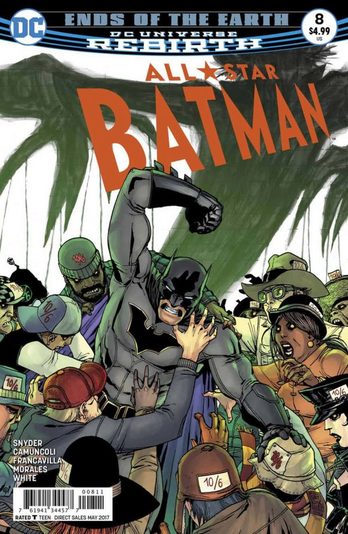Written by Joel T. Lewis This month it seems that Batman’s efforts to contain the plague set loose by Mr. Freeze have been successful thanks to the cooperation of Pamela Isley but during the course of that mission, Batman and Duke Thomas have been relentlessly pursued by a strike team known as the Blackhawks. This group of operatives are equipped with unique body armor that features an advanced camouflage technology which manipulates how the brain interprets eye movement in order to trick the mind into seeing whatever the user wants. Batman’s research on this advanced technology has led him to the lavish estate of Jervis Tetch and the Dark Knight has some questions for the madcap haberdasher. Upon arriving at the Tetch Estate, Batman is confronted by Nightwing, Batwoman, and Red Hood. Picking up on subtle cues that lead him to believe that these people are not members of the Bat-Family, Batman proceeds to subdue each in turn. The crumbled heap of imposter’s camouflage falls away to reveal members of the Blackhawks. Batman then confronts Mad Hatter directly but quickly falls under the hallucinogenic influence of a gas Jervis has polluted the air with. This coupled with the appearance of more Blackhawks whose camouflage armor shifts and distorts Batman’s grip on reality, sends the caped crusader on a psychedelic journey. The Mad Hatter’s mind control hats and his ability to manipulate his victim’s perceived reality has always made him a formidable opponent, despite his childish obsession with Alice in Wonderland, and this issue is no exception. One of the most fascinating components of the Batman mythos is when an author finds a way to explore an alternative series of events that might have taken place during the formative days of the dark knight. In this issue we get to see a distorted vision of what Bruce Wayne’s life might have been if the Hatter had gotten into his head before he became Batman. That version of reality, while thankfully hallucinatory, is haunting and fascinating. The cerebral focus of this issue is strengthened by the introspective style of narration that Scott Snyder uses. By letting us into Bruce’s thoughts as he navigates the topsy-turvy madness laid out for him by the Mad Hatter, Snyder intensifies our sense of disorientation as Bruce’s confusion becomes our own. Hatter weaves a tale of manipulation going back to the first days of Bruce’s vigilantism, claiming that he slipped one of his reality twisting tags into Wayne’s ball cap and saw him take his first steps into Gotham’s underworld. He also claims to have fabricated the fantasy of Batman by activating the tag he planted with the Alice in Wonderland quote, 'Twinkle, Twinkle, Little Bat.' In this reality, Bruce broke his neck on his first outing into Gotham’s underworld, and Batman is the desperate fantasy of a man confined to a wheelchair. Through this lens, Hatter shows key members of Batman’s rogue’s gallery to be echoes of Alice in Wonderland characters: Monstrous Bane is the Jabberwocky, mischievous Catwoman is the Cheshire Cat, Riddler stands in for the Caterpillar, and Joker and Harley Quinn are the King and Queen of Hearts. Terrifying as this distorted reality is, Batman manages to break through the madness and interrogate the diminutive hat-maker. The issue concludes with Tetch hinting at an unknown villain who’s responsible for mobilizing the Blackhawks. But we’ll have to wait till next month to discover who the unknown puppeteer is as Snyder doesn’t give us any hint as to who the villain might be. Something that continues to impress me about the All-Star Batman series is Scott Snyder’s determination to give Batman a sense of humor. In an issue as psychological and twisted as this month’s was, Snyder’s humor shines through all the more. Instead of taking Batman to the dark and gritty places made famous by authors like Frank Miller, Snyder lets Batman quip and play in a way that breathes new life into the character. That’s not to say that Snyder’s humor is heavy-handed or detracts from the narrative. Snyder adds just a bit here and there like when he’s fighting the Nightwing imposter, Batman clubs him with a mechanical lawn flamingo, like the Queen in Alice in Wonderland does when playing croquet, or when considering how he was able to identify the Blackhawks as impostors Batman says, 'My family knows how to #$%^ fight.' Perhaps my favorite example of Batman’s humor comes when he’s confronting Mad Hatter at the end of the issue, the tiny villain’s voice has turned into a high-pitched whine, to which Batman smirks, 'I let him tell Aquaman.' Snyder keeps enough humanity in this version of Batman to lighten the mood when necessary which allows All-Star Batman to avoid being dreary. Next month we discover the villain behind the Blackhawks! Until next time, Geek On!
0 Comments
Leave a Reply. |
Archives
May 2024
|
|
© 2012-2025, Nerds That Geek LLC.
All Rights Reserved. |
uWeb Hosting by FatCow
